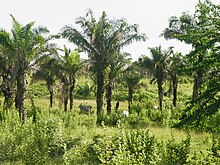Attalea phalerata
| Attalea phalerata | |
|---|---|

| |
| Scientific classification | |
| Kingdom: | Plantae |
| Clade: | Tracheophytes |
| Clade: | Angiosperms |
| Clade: | Monocots |
| Clade: | Commelinids |
| Order: | Arecales |
| Family: | Arecaceae |
| Genus: | Attalea |
| Species: | A. phalerata
|
| Binomial name | |
| Attalea phalerata | |
| Synonyms | |
| |
Attalea phalerata is a species of palm tree known by the English common name urucuri palm, the Portuguese common name urucurizeiro, and the Spanish common name shapaja.[1] Other common names include motacu[2] and bacuri.[3] It is native to Brazil, Bolivia, Paraguay, and Peru,[1] where it grows along southern and western Amazonia.[4] It is the most common palm tree on the Pantanal.[5]
Description
This palm grows up to 18 metres (59 ft 1 in) tall, the trunk rarely reaching more than 4 metres (13 ft 1 in).[6][7] It has up to 30 feather-like leaves.[7] The bright orange fruits are up to 11 centimetres (4.3 in) long.[7]
Ecology
This palm species is of ecological importance and grows in many types of forest; individuals become fertile at 7-10 years of age (1 m height).[6] Flowering occurs throughout the year and fruiting twice per year.[6] The seeds are dispersed by tapirs, which swallow the fruits whole,[8] and by rheas, agoutis, spiny rats of genus Clyomys, and caracaras. The hyacinth macaw consumes the seeds and may disperse them, as well.[3] The sheaths of the palm often accumulate the seeds of other plants, which are sometimes deposited there by Artibeus jamaicensis, a frugivorous bat. The seeds sometimes germinate there and grow as epiphytes on the palm tree.[5] This palm tree is commonly pollinated by sap beetles of genus Mystrops and weevils of tribe Madarini.[9] The weevil Pachymerus cardo is known to be a seed predator on this species.[8] Rhodinus stali, an insect which is a vector of Chagas disease, may infest this tree.[2]
Uses
The tree has human uses. The leaves are used to thatch rooftops and the fruits are fed to pigs and other livestock.[2] It is a source of vegetable oil.[10] It is one of the most economically important palm species in Bolivia, where it is known as motacú.[6][11]
References
- ^ a b "Attalea phalerata". Germplasm Resources Information Network. Agricultural Research Service, United States Department of Agriculture. Retrieved 25 January 2018.
- ^ a b c Justi, S. A., et al. (2010). Infestation of peridomestic Attalea phalerata palms by Rhodnius stali, a vector of Trypanosoma cruzi in the Alto Beni, Bolivia. Tropical Medicine and International Health 15(6) 727-32.
- ^ a b Galetti, M. and P. R. Guimarães Jr. (2004). Seed dispersal of Attalea phalerata (Palmae) by Crested caracaras (Caracara plancus) in the Pantanal and a review of frugivory by raptors. Ararajuba 12(2) 133-35.
- ^ Choo, J., et al. (2010). Characterization of 14 microsatellite loci in a tropical palm, Attelea phalerata (Arecaceae).[dead link] American Journal of Botany e105-e106.
- ^ a b Corrêa, C. E., et al. (2012). Seed banks on Attalea phalerata (Arecaceae) stems in the Pantanal wetland, Brazil. Annals of Botany 109 729-34.
- ^ a b c d Barthlott, W. and M. Winiger. Biodiversity: A Challenge for Development Research and Policy. Springer 2001.
- ^ a b c "Attalea phalerata - Palmpedia - Palm Grower's Guide". www.palmpedia.net. Retrieved 2018-10-27.
- ^ a b Quiroga-Castro, V. D. and A. I. Roldán. (2001). The fate of Attalea phalerata (Palmae) seeds dispersed to a tapir latrine. Biotropica 33(3) 472-77.
- ^ Fava, W. S., et al. (2011). Attalea phalerata and Bactris glaucescens (Arecaceae, Arecoideae): Phenology and pollination ecology in the Pantanal, Brazil. Flora - Morphology, Distribution, Functional Ecology of Plants 206(6) 575-84.
- ^ R., M. Moraes., et al. (1996). Notes on the biology and uses of the Motacú Palm (Attalea phalerata, Arecaceae) from Bolivia. Economic Botany 50(4) 423-28.
- ^ Brokamp, Grischa (2015). Relevance and Sustainability of Wild Plant Collection in NW South America: Insights from the Plant Families Arecaceae and Krameriaceae. Wiesbaden: Springer Spektrum. doi:10.1007/978-3-658-08696-1. ISBN 978-3-658-08695-4. S2CID 30557398.
